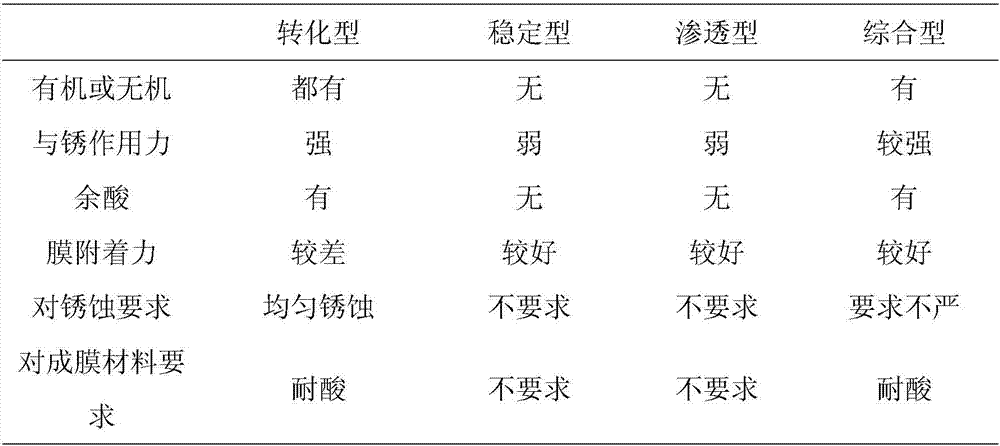Water-based rust conversion priming paint and preparation method
A technology of rust conversion and rust conversion agent, which is applied in coatings, anti-corrosion coatings, etc., can solve the problem of destroying the integrity of the conversion film, and achieve the effects of strong resistance to salt spray penetration, good coating quality, and strong permeability
- Summary
- Abstract
- Description
- Claims
- Application Information
AI Technical Summary
Problems solved by technology
Method used
Image
Examples
Embodiment 1
[0040] A water-based rust conversion primer, by weight, consists of 48 parts of vinylidene chloride composite polymer emulsion, 30 parts of pigment paste, 12 parts of 2-hydroxypropyl 3,4,5-trihydroxybenzoic acid rust conversion agent , 0.05-0.1 part of defoamer, 0.1-0.5 part of thickener.
[0041] Its preparation steps are: 1) synthetic rust conversion agent: add 30.6g 1-2 propanediol in four-neck flask and place in cold water bath, add 10.2g gallic acid and 1.02g p-toluenesulfonic acid in proportion under stirring condition, water bath Raise the temperature to 70°C, stir and react for about 1 hour. After the solid matter is completely dissolved, the system turns light yellow; raise the temperature of the system to 105°C, maintain a constant temperature, stir with a stirrer for 2.5-3 hours, cool down and discharge to obtain the rust conversion agent.
[0042] 2) Add 25.0g deionized water into the beaker, add 9.0g aluminum tripolyphosphate, 12.0g talcum powder, 2.0g barium sulf...
Embodiment 2
[0044] A water-based rust conversion primer, by weight, consists of 45 parts of vinylidene chloride composite polymer emulsion, 25 parts of pigment paste, 10 parts of 2-hydroxypropyl 3,4,5-trihydroxybenzoic acid rust conversion agent , 0.05-0.1 part of defoamer, 0.1-0.5 part of thickener.
[0045] Its preparation steps are: 1) Synthetic rust conversion agent: add 27g 1-2 propylene glycol in four-necked flask and place in cold water bath, add 6.75g gallic acid and 0.7g p-toluenesulfonic acid in proportion under stirring condition, water bath temperature Raise to 75°C, stir and react for about 1 hour. After the solid matter is completely dissolved, the system turns light yellow; raise the temperature of the system to 110°C, maintain a constant temperature, stir with a stirrer for 2.5-3 hours, cool down to room temperature and discharge to obtain the rust conversion agent.
[0046] 2) Add 20.0g deionized water into the beaker, add 9.0g aluminum tripolyphosphate, 10.0g talcum powd...
Embodiment 3
[0048] Step 1) is the same as Example 2, step 2): add 25.0g deionized water in a beaker, add 6.0g aluminum tripolyphosphate, 8.0g talcum powder, 10.0g barium sulfate and 4g nano silicon dioxide successively under stirring, After uniform dispersion, it is ground on the equipment until the particle size is less than 20 microns, and the resulting pigment paste is obtained. Add 55.0g of vinylidene chloride composite polymer emulsion into the beaker, and stir evenly; add the above-mentioned pigment and filler slurry into the emulsion, stir for about 15 minutes, add 10g of the rust converting agent prepared in Example 1, and check the bubbles during stirring Add an appropriate amount of defoamer, add an appropriate amount of thickener to thicken, and stir for 30 minutes. A water-based rust conversion primer that can be painted with rust is obtained.
PUM
 Login to View More
Login to View More Abstract
Description
Claims
Application Information
 Login to View More
Login to View More - R&D
- Intellectual Property
- Life Sciences
- Materials
- Tech Scout
- Unparalleled Data Quality
- Higher Quality Content
- 60% Fewer Hallucinations
Browse by: Latest US Patents, China's latest patents, Technical Efficacy Thesaurus, Application Domain, Technology Topic, Popular Technical Reports.
© 2025 PatSnap. All rights reserved.Legal|Privacy policy|Modern Slavery Act Transparency Statement|Sitemap|About US| Contact US: help@patsnap.com


